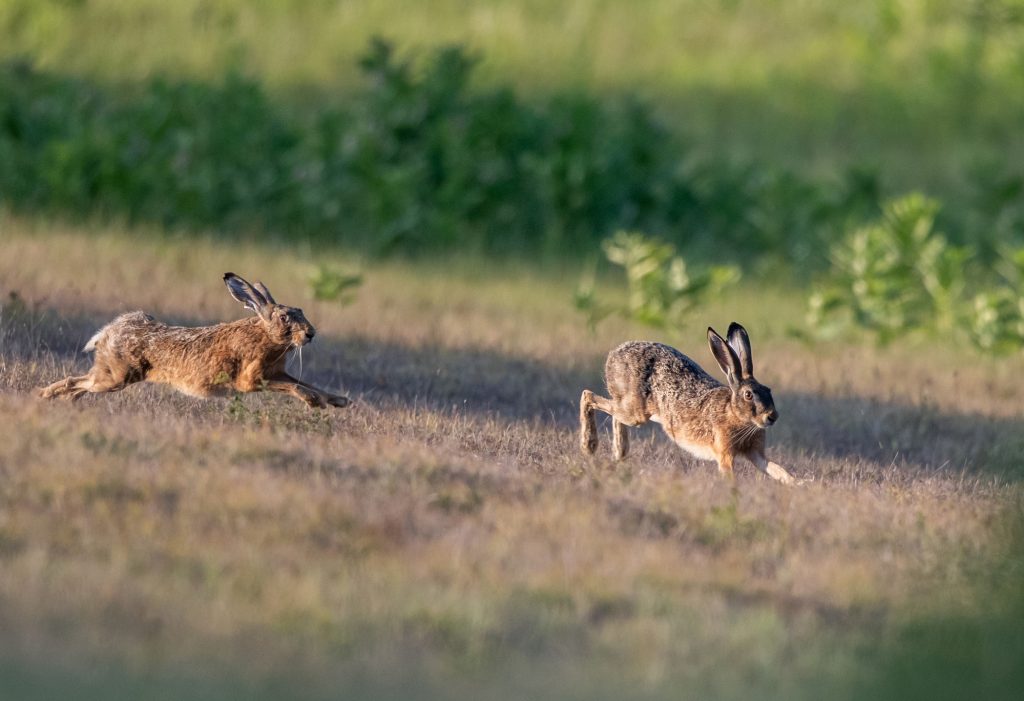As entertaining it is to watch rabbits run circles around each other, there is more to this behavior than just the fun of the chase. This article will dive into the most common reasons why rabbits chase each other and when this chasing is cause for concern.
Why Do Rabbits Chase Each Other?
Rabbits chase each other for a number of reasons, such as courting, dominance, or even entertainment. In some instances, the chasing is harmless. However, the situation should be monitored, and intervention is required with any signs of aggression to prevent fighting – especially in rabbits that have not bonded completely.
Reasons Why Rabbits Chase Each Other
If you are new to owning rabbits, observing them chasing each other may appear harmless if you don’t know any better.
Though it might not always be a problem, and sometimes your bunnies are really just playing, there are certain behaviors that you have to look out for and step in as referee to keep the situation under control.
Bonding and Playing
In nature, many animals travel in packs; this is as much for protection (in numbers) as it is for the social needs they have. There are a couple of exceptions, but very few animals thrive on being alone.
Rabbits are social creatures and primarily live within colonies. Some pet owners have had the misfortune of losing both bunnies when one has passed away; this is because rabbits occasionally die from loneliness when they lose a bonded mate.
As social they might be, rabbits in the wild have been observed fighting with other colonies and even within their own territory. This is primarily a territorial thing.
When you have two rabbits that have not bonded, chasing can quickly lead to fighting. With rabbits that are already bonded, chasing might just be playing, courting, or showing some (mainly) harmless dominance.
There is no need to intervene with bonded rabbits unless they show clear signs of aggression that will more than likely lead to a fight.
Courting
Animals are well-known for having certain rituals when it comes to impressing the opposite sex. Bucks and does chasing each other is normal when it comes to mating.
There is no genuine concern when this happens, and it’s all just part of the ritual. But keep an eye on the doe; she might not be in the mood and can become annoyed with the buck.
Though it won’t happen very often, she might get a little aggressive if he insists on mating.
Dominance
The dominant rabbit may want to remind the submissive of his or her position. Gender is not really a factor when it comes to rabbit dominance.
Does can easily be the dominator and the male the submissive. You will also notice that your doe might mount a male after he bred her; this is to assert her dominance as the boss-lady.
Dominant rabbits can be seen running circles around an unmoving rabbit (usually the submissive) as a sign of dominance.
In the wild, rabbits follow a dominance hierarchy; in short, rabbits have ranking orders, and the highest rank will usually enjoy the first option on food and mating privileges.
At times, these behaviors will still be evident in domesticated animals and should not cause too much trouble if the lower ranks stay in line.
Fighting
When rabbits chase each other while showing signs of aggression like kicking and biting – and not just a nip here or there – they are likely fighting.
The conflict between your bunnies can arise when they are not properly bonded, unneutered, or sometimes they can annoy each other.
Keep an eye out for “spinning” rabbits; when they run tight, fast circles around each other, it might be a good time to call for a time out before they get into a scuffle.
Watch the video below of two rabbits fighting; this will help you recognize fighting and tell it apart from playing.
As cute and fluffy as they are, bunnies can seriously injure and even kill another rabbit when they fight.
Conflict is more common in unneutered males but can occur across genders. In the wild, fighting is a way to establish dominance in the hierarchy; once the colony has set its order, the fighting tapers down.
Ways To Prevent Your Rabbits From Chasing Each Other
If your bunnies are running around playing, there is little reason to foil harmless fun. However, if you sense hostility between your rabbits you can do a few things to prevent the behavior and avoid conflict.
Perhaps the most essential step to take is to introduce your rabbits properly.
Bonding or Re-bonding
Bonding your rabbits is necessary for a relatively peaceful existence. A reasonable frame of reference is to think about bringing a new cat or even a kitten home to meet your adult cat.
More often than not, if you rush the process, it will result in fighting. You have to allow them some time to get used to each other. Start slow and work your way up to get them to relax with the new addition.
If they chase, discourage it immediately by placing them next to each other and giving them treats. If they fight, separate them and try again once they have calmed down.
On some occasions, bonded rabbits may start fighting, which could mean that you’ll have to start the process again.
On her website, The Bunny Lady, Amy, a life-long lover of rabbits, shares her tips on creating a lasting bond between your pets.
With her experience with these fluffy animals, Amy found that it can take anything from just two weeks up to a couple of months to have your bunnies live together in harmony; you’ll need a lot of patience.
Her video below will get you started on the road to keeping happy rabbits.
Opposites Attract
When you have many intact males with just a few fertile females, you might be asking for trouble.
Keeping two males or two females together may result in fighting – especially when they are still in possession of all their mating bits and pieces. You might find that your girls can coexist quite peaceably, but your boys might become a little challenging.
Chasing and fighting may easily be solved by separating your bucks.
A Trip to the Vet
Getting your bucks neutered and spaying your does will significantly improve their social behavior. Experts state that in some cases, not having them desexed can prevent bonding, and they might never get along.
Some of the easiest and most successful bonding experiences happen between neutered males and spayed females. Same-sex bunnies that have been altered coexist more peacefully, although there still may be occasional playful chasing.
Additionally, rabbits have a lot of babies, which is another good reason to keep sterile pets. Animal welfare organizations are overwhelmed with unwanted or stray bunnies, cats, and dogs (amongst various other animals).
Preventing your rabbits from having litter after litter is simply the responsible thing to do.
Conclusion
Chasing is harmless unless rabbits show signs of aggression, such as spinning around each other, biting, or kicking. In these cases, you have to separate them and reinforce their bond.
For the best bonding experience and to avoid constant conflict, experts suggest that owners desex bunnies and keep opposite sexes together instead of same-sex rabbits.

